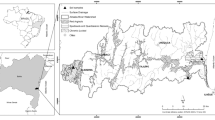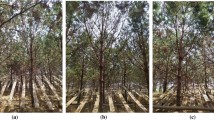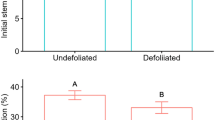Summary
In a pot study, flooding reduced growth of loblolly pine (LP) seedlings and caused an imbalance of nutrients, particularly Fe, in the tops. Swamp tupelo (ST) suffered none of these problems. Also under anaerobiosis, LP roots leaked 85 percent of total ethanol production into solution whereas ST leaked only 55 percent. Application of phosphorus increased LP growth under flooded and drained conditions but ST only under drained conditions. The differential response of the two species to flooding suggests that poor energetics and the leaky nature of LP roots under anaerobiosis restricts its growth in such habitats. Application of phosphorus (P) appears to amend these conditions in LP by reducing moisture stress, reducing nutrient imbalances, and improving energetics in older seedlings. Our results confirm that ST, the hydrophyte, avoids the problems of soil flooding via adaptations in anaerobic metabolism and oxidation of the rhizosphere.
Similar content being viewed by others
References
Bray R H and Kurtz L T 1945 Determination of total, organic, and available forms of phosphorus in soils. Soil Sci. 59, 39–45.
DeBell D S, Hook D D, McKee W H Jr, and Askew J L 1983 Water table level and applied phosphorus affect morphology and physiology of loblolly pine root systems.In preparation.
DeBell D S and Naylor A W 1972 Some factors affecting germination of swamp tupelo seed. Ecology 53, 504–506.
Gambrell R P and Patrick W H Jr 1978 Chemical and microbiological properties of anaerobic soils and sediments.In Plant Life in Anaerobic Environments. Eds. D D Hook and R M M Crawford. Ann. Arbor. Science, Ann Arbor, MI. 564 p.
Gutman I and Wahlefeld A W 1974 L-(−)-Malate determination with malate dehydrogenase and NAD.In Methods in Enzymatic Analysis Ed. H V Bergmeyer. Academic Press, New York. pp 1585–1589.
Haldar M and Mandal L N 1981 Effects of phosphorus and zinc on the growth and phosphorus, zinc, copper, iron, and manganese nutrition of rice. Plant and Soil 59, 415–425.
Hook D D and Brown C L 1973 Root adaptations and relative flood tolerance of five hardwood species. For. Sci. 19, 225–229.
Hook D D and Brown C L 1971 Inductive flood tolerance in swamp tupelo (Nyssa sylvatica var.biflora (Walt.) Sarg.). J. Exp. Bot. 22, 78–89.
Jackson M L 1958 Soil chemical analysis. Prentice-Hall, Inc. 498 p.
Keeley J E 1979 Population differentiation along a flood frequency gradient: Physiological adaptations inNyssa sylvatica. Ecol. Monogr. 49, 89–108.
McKee W H Jr, Hook D D, DeBell D S, and Askew J L 1983 Effects of controlled water depth and phosphorus on growth and nutrient uptake of two-year-old loblolly pine.In preparation.
Nelson D W and Sommers L E 1973 Determination of total nitrogen in plant material. Agron. J. 65, 109–112.
Pritchett W L 1979 Properties and Management of Forest Soils. John Wiley and Sons, New York. 500 p.
Shadan M 1980 Fixation, translocation and root exudation of14CO2 byPhaeseolus vulgaris L. subjected to root anoxia. M. S. Thesis, Michigan State University.
Smuckers A J M and Erickson A E 1982 Unpublished data on anaerobiosis as it affects the exudation, growth and infection of pea roots.
Author information
Authors and Affiliations
Additional information
Supported in part by a Cooperative Agreement with the USDA, Forest Service, Southeastern Forest Experiment Station, Asheville, NC.
Rights and permissions
About this article
Cite this article
Hook, D.D., Debell, D.S., McKee, W.H. et al. Responses of loblolly pine (mesophyte) and swamp tupelo (hydrophyte) seedlings to soil flooding and phosphorus. Plant Soil 71, 387–394 (1983). https://doi.org/10.1007/BF02182680
Issue Date:
DOI: https://doi.org/10.1007/BF02182680




